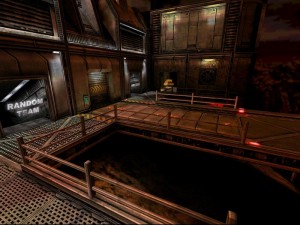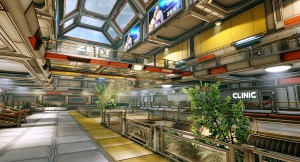Interview: Thiago Klafke, Environment Artist at Blizzard Entertainment
(Published on: March 20th, 2012)
You don’t know Zest Foundation? That’s not possible! Meet Zest’s author – Thiago Klafke, Environment Artist at Blizzard Entertainment.
Mateusz: Hi, tell us something about you. Where your passion came form?
Thiago: Hello there! My name is Thiago Klafke, I was born in Brazil and I currently live in Irvine, CA, where I work as an environment artist at Blizzard.
I always wanted to create videogames but never knew how to start. Until one day that I bought a magazine filled with weird game development tools. My first experiments were with RPG maker and I loved how easily you could create characters, levels and enemies with that! After that I fell in love with IRC scripting and even created a bot for automated RPG fights. It had stats, items, leveling up and you could even fight other users. It was pretty neat but never successful. That was a great learning experience and even though I don’t code nowadays I have a small idea of how it works.
After that I found out that one could create levels for Half-Life and was fascinated by it. It was exactly what I was looking for: Complete freedom to create 3D worlds. I loved how simple the editor was and spent quite a deal of my teenage years locked inside my room working on those maps.
I never thought I could work professionally until other fellow MapCore (a game dev forum) members started getting jobs in the industry. That was when I started to take things seriously and joined a few mod projects. They were a very valuable experience because I got a glimpse of how working at a game studio would be like.
After that I landed my first job in the industry creating environment assets for a Deer Hunter game developed by the now defunct Southogic Studios (RIP). Then I worked at the Sao Paulo branch of Ubisoft for 2 years on DS and PSP games, with the greatest team that country has ever seen. Too bad we were never able to use our full potential.
And now I moved to sunny California to work at Blizzard.
M: Why did you choose games industry?
T: I heard about free snacks & soft drinks and people driving Ferraris and that sounded like fun!
M: Those Ferraris and free snacks were true?
T: Yes definitely but I still have a looooooong way to buy my Ferrari.
M: What is Environment Art all about? How your typical workflow looks like?
T: I like working in a non-linear way. I always admired artists who can properly blockout a map and then do a complete texture pass at once, then a geometry polish pass, a lighting pass etc.
I also like to create a small library of tiling textures before doing any heavy modeling work. This way I can unwrap stuff as I go and reuse what I already have smartly. I believe this has to do with how we worked back in the HL days, creating crazy unique geometry out of the same trim textures.
At the end of the day what matters is the job done though, so just work in whatever way fits your style.
M: Let’s talk about “Zest Foundation”, tell me where the idea to create such a scene came from? How did you start and how did it end up?
T: That project started as a simple scene where I was experimenting with modular assets creation. I was very inspired by the art in Mass Effect and wanted to “reverse engineer” what they did but using my own ideas instead.
The first version looked like this:
I was using a lot of “unique” textures for those pieces and I noticed that that would not be the best way to build the environment that I wanted. Using tiling textures gives you a lot more freedom to edit the pieces and expand the set later on. So I restarted the scene using what I had learned from that small experimentation and it slowly turned into Zest Foundation.
As for ideas they came from everywhere really, specially Syd Mead’s artworks, old school sci-fi classics such as Buck Rogers, and even old “Metal Hero” Japanese shows I used to watch when kid, such as Jaspion and Jiban.
I wrote a making of for that environment and you can read it on my site: www.thiagoklafke.com
M: It sounds like you have a full control on the shape of the environments you’re working on. What happens when Level Artist or Level Designer makes his blockout totally wrong?
T: I haven’t came accross that problem yet but that usually means a lot of reworking :)
As a former level designer I have experience with that as well so I always try to contribute a bit on that regard, either giving feedback or actually placing my own assets in the level.
If you want to work on the industry as an environment artist definitely get some level design experience I’d say. Even if you don’t make the best levels ever that knowledge will surely come in hand one day.
M: In your opinion, how cooperation between Level Designers and Environment Artists should look like?
T: This is a tough question because it deals with how the structure in a studio is like. There’s no rule for this and this structure usually varies wildly between studios.
But I like to see the level designers as my “clients”, in the sense that I’m providing “building kits” for them to work with. This is even more important when creating modular sets that will be reused a lot in the game. You need to take in consideration both the LDs needs and the art needs. These kits need to be created in a way to facilitate placement (it’s always easier to place big chunks than thousands of small objects for example) and your art also shouldn’t get in the way of the gameplay.
So the way I see it is that the environment art should complement and empower the level design.
M: Are first steps in game industry hard?
I believe it is in any industry if you want to be successful. If you go down the education route you need to be careful when it comes to picking a school. There are a lot of schools out there forming “jack of all trades” students. That’s fine if you want to work on small local projects but if you have bigger ambitions and want to work at big companies I’d recommend picking a more specialized school. Getting a degree in fine arts instead of game design if you want to be an artist I mean.
Again, a degree is completely worthless if you are not able to do the job. A portfolio is worth a thousand times more than a piece of paper.
Most of my friends in the industry came from the mod/indie dev community and frankly, that’s still the best way to get into it in my opinion. Just do whatever helps you build a portfolio!
There’s an infinite amount of free information on the web, all you need is passion, commitment and patience.
M: You had to move to a different country. How it went?
It’s a lot of work but damn worth it in my opinion!
Getting the visa was one of the most stressful things I have ever endured. I don’t have a degree so I had to go for another type of visa which requires a lot more documentation and work. So if your ultimate plan is to get a job in the US maybe that degree will definitely help.
Besides that the transition was super smooth. The culture here in California is not very different from Brazil so I never had any problems adapting.
My only difficulty so far has been the food. My friends probably can’t stand me bitching about this anymore but the food here is horrendous. On the bright side that’s forcing me to get better at cooking so in the end that’s actually a good thing.
M: What are the best and worst parts of your job?
T: Best: Creative freedom and doing something I like.
Worst: Sometimes you come across clueless people making big (and wrong) decisions.
M: Any ideas to solve that problem?
T: I don’t know, that will come with time I guess. The problem is that there are many people in managerial positions who lack any basic production experience. That’s a reflection of our industry being so young.
M: What if you’re out of ideas? Where you’re looking for inspiration? What kind of references you’re using?
Everything. Mostly recently I’ve been using a lot of Google Street View. You can find any kind of reference you want there, be it derelict industrial districts or high-end skyscrapers.
Besides that I like watching weird old movies. There are quite a few gems out there that nobody has heard about. I’m not one of those types who only watch “obscure” stuff to look cool in a conversation but I do enjoy watching different things so I can get different references than other people.
M: Have you ever tried different jobs?
T: Yeah just like everyone else I took some shitty jobs in the past to pay the bills and get some experience. Didn’t like them one bit…
I also tried a bit of graphic design but never found it really fun. It was cool for a while but then I noticed that I spent most of the days just thinking of what kind of environments I’d work on when I get home :P
M: Do you think that it is hard to find a job in the industry as an Environment Artist?
T: Depending on where you live, yes. It’s close to impossible to find a job as Environment Artist in Brazil now for example, as most devs there are doing small mobile or social games. I worked two years for Ubisoft and I barely made any environment art there during that time.
The great part about the games industry is that if you build a great portfolio companies will do whatever they can to bring you over. As long as you are OK with moving to another city or country that is.
M: What is the best thing to put into a portfolio?
T: Always keep your portfolio up-to-date and with your best works only. It’s always best to have 1 or 2 really good and complete works than a bunch of WIPs and old shit.
M: What games you enjoyed last time or ever and what you can recommend?
T: I like playing all kinds of games to be honest, but I specially like sandbox games.
If you asked me what’s the best game of this generation I’d say it is Red Dead Redemption. That game excels in every department in my opinion. Even if some of the art is not exactly great, the lighting in the engine makes everything look cohesive. And the terrain is awesome.
This game also has a very rare “feature” these days: good writing. I don’t know what happened along the way but 99% of games nowadays seem to be written by angry 12 year old kids.
Besides that I’m a huge fan of the Fallout series, Mass Effect (the first one) and have also been playing a lot of Starcraft 2.
M: Where readers can find you?
The best place to see my work is my portfolio: www.thiagoklafke.com
Besides that I’m always hanging out at mapcore.net.
M: Thanks Thiago, good luck!
Thanks for this opportunity; it was fun answering these questions!





